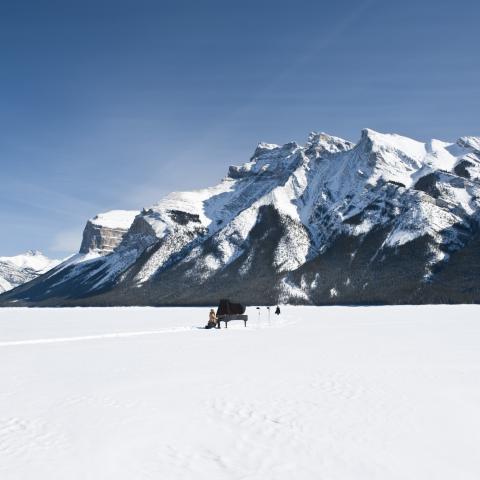Ragnar Kjartansson
January 30 – April 18, 2010
Ragnar Kjartansson, production shot "The End" (2009). Photo: Laura Vanags. Courtesy of the artist, Luhring Augustine, New York and i8 Gallery, Reykjavik.
Kjartansson and Þór Jónsson then filmed and recorded the song’s instrumental parts in five idyllic and sublime sites around Banff in temperatures as low as -20 degrees Celsius. The resulting projections were arranged to echo one another, Kjartansson and Þór Jónsson performing multiple parts of the same song in the guise of somewhat ambiguous country musicians.
Using the Rocky Mountains as a stage set to perform the historically romanticized role of the artist in the landscape, Kjartansson questions the cultural narratives that mediate our experiences of nature. All the while the work’s melancholic beauty and intoxicating soundtrack prove overwhelmingly romantic, eliciting a curiosity in the contemporary abyss.
Ragnar Kjartansson
The artistic practice of Icelandic based artist Ragnar Kjartansson is characterized by experiments in visual art, music, and theatre. Working primarily as a performance artist, his pieces play on contradictory feelings of sorrow and happiness, horror and beauty, drama and humour. Kjartansson graduated from the Icelandic Academy of Arts in 2001 and since then has presented his performances and related videos, installations, and paintings in numerous exhibitions worldwide. Kjartansson garnered international attention through his contribution to the 2005 Reykjavík Arts Festival, where he staged an abandoned meeting house in the countryside of Southern Iceland. For Manifesta 7 he presented Schumann Machine (2008) a restaging of Robert Schumann’s Dichterliebe as a psychedelic and absurd loop. Ragnar Kjartansson has been selected to represent Iceland in the 2009 Venice Biennale. His residency is supported in part by the The Benediktson Fellowship for Icelandic Artists.
Davíð Þór Jónsson
Davíð Þór Jónsson is one of Iceland’s leading Jazz musicians. He has collaborated with a whole spectrum of artists, from obscure troubadours in the countryside to stadium bands. David has played on almost 100 records covering all fields of music, both in Iceland and abroad. He released his first album RASK in 2002 and the record Vottur in 2004 with his trio Flis. He has collaborated with Ragnar Kjartansson on various works. Most notably David wrote the music for God, performed in the Schumann Machine and is currently working as a composer for Ragnar’s Venice Biennale project. Jónsson also composes a great deal of music for theatre, film and art installations of all kinds. His main goals in music are to never stop childlike enthusiasm and to free the world from the boring jazz.
